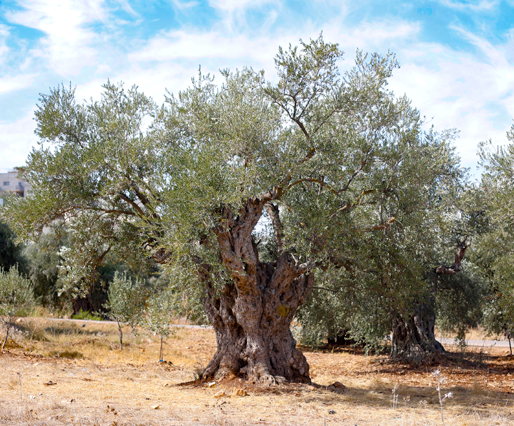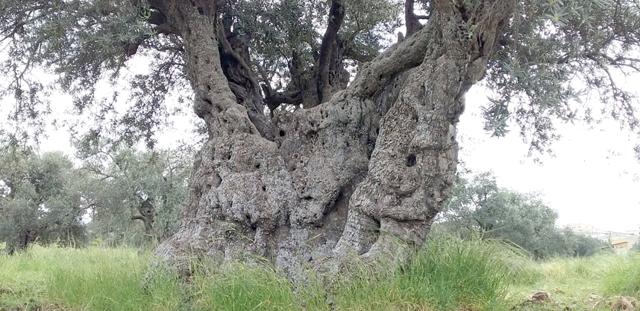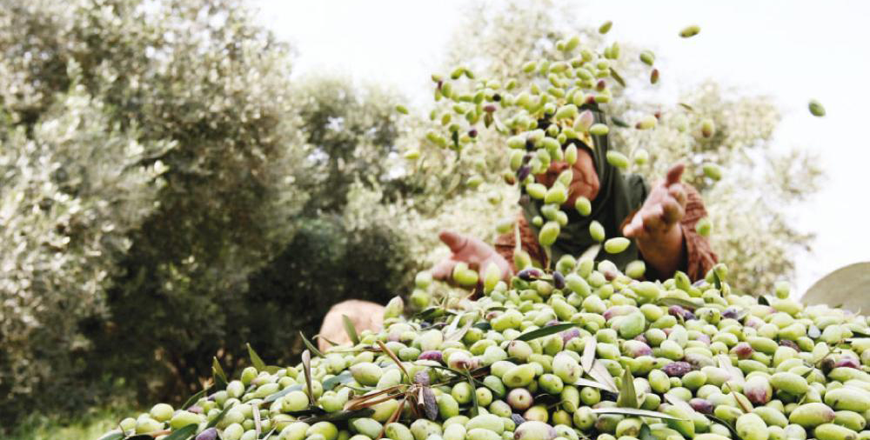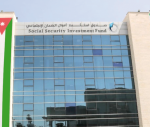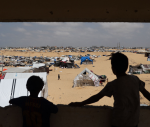You are here
Olive oil harvest in Jordan hit hard by climate change, farmers experience drastic reductions in yields
By Mays Ibrahim Mustafa - Nov 18,2023 - Last updated at Nov 19,2023

Olive oil has not escaped the impacts of climate change on food production in Jordan (Photo courtesy of NARC)
AMMAN — A source of income for thousands of Jordanian families and a sizzling commodity present in all households across the Kingdom, olive oil has not escaped the impacts of climate change on food production in Jordan.
Hasan Smadi is an olive farmer in Ajloun, a town in northern Jordan, some 76 kilometres north west of Amman. He pressed the first patch of his olive harvest for this year on October 22.
To his disappointment, that patch, which included 50 kilogrammes of olive fruits, only yielded six kilogrammes of olive oil.
The 48-year-old, who inherited his land from his father and his grandfather before him, has been a farmer for most of his life. He noted that this season has been particularly difficult with the felt impacts of climate change taking a toll on his harvest.
Smadi, an agricultural engineer, added that the reduced amount of extracted olive oil “was not surprising” to him, considering the difficult weather conditions which impacted the Kingdom this year, including changes in rainfall patterns during winter and prolonged heatwaves during summer.
Smadi also pointed out that the percentage of oil extracted from pressed olives only recently began to improve, returning to the usual levels of nine to 12 kilogrammes of oil per each 50 kilogrammes of olive fruits.
Minister of Agriculture Khalid Hneifat opened the olive milling season for this year on October 17, the Jordan News Agency, Petra, reported.
In an interview with The Jordan Times last month, Head of the Olive Research Department at the National Agricultural Research Centre (NARC) Ibrahim Al Amad explained that the impacts of climate change had led to delays in the flowering and fruit-setting stages of olives in Jordan.
NARC had then recommended delaying opening olive presses across the Kingdom until October 25 to ensure that olives are ripe enough for milling. However, some mill owners protested this decision for fear that the delay will impact their businesses.
Olive farmers have since complained that the amount of oil extracted upon milling their harvest is very low, compared with last season, with many questioning the efficiency of production lines in olive presses.
Kingdom operates modern olive presses
There are 145 olive presses distributed across the Kingdom, of which 141 are modern ones, operating two-phase and three-phase centrifugation systems, according to NARC.
These rely on a “cold” pressing method, by which the temperature inside production lines does not climb over 27ºC, said Head of the Olive Research Department at NARC Ibrahim Al Amad.
As the olive oil season begins, owners of olive presses usually test the efficiency of production lines before receiving farmers’ produce, he added.
Amad noted that is done by “trial” milling half a tonne of olives for each line and calculating the yielded amount, then comparing it to laboratory results on the percentage of oil carried in the fruit.
Climate change threatens livelihood of thousands of Jordanian families
Smadi, the olive farmer interviewed by The Jordan Times, said that heatwaves have increased his use of fertilisers, and forced him to resort to supplementary irrigation to sustain his olive trees.
He also noted that other production costs, including labour and transport, have marked a significant increase this year, adding to the burden of financial losses he suffered due to his reduced olive oil yield.
“Because fuel prices increased, the truck which transports my olive harvest to the olive mill charged JD15 instead of JD10 this year,” he said, adding that the production cost of a 16kg tin of olive oil has increased from JD60 to JD75 this season.
The price of a 16kg tin of olive oil often ranges between JD85 to JD90, depending on its quality. This season, its price has increased to JD100, according to local consumers who spoke to The Jordan Times.
NARC Director-General Nizar Haddad stressed that olive oil is a vital source of income for over 80,000 Jordanian rural families, across various governorates.
He told The Jordan Times that the olive oil sector is one the most important economic and agricultural sectors in Jordan, actively contributing to its gross domestic product (GDP) with an investment volume exceeding JD1 billion.
The Kingdom is home to approximately 12 million fruit-bearing olive trees and an estimated 2 to 3 million olive trees, which have not yet come into maturity. These cover an area of 640,000 dunums, and account for 74 per cent of the area cultivated with fruit trees, according to Haddad.
He noted that olive trees in Jordan yield up to 250,000 tonnes of olive fruits annually, approximately 50,000 tonnes of which are used for picking purposes, while the remaining 200,000 are milled.
He added that the volume of olive oil production this year is expected to reach between 30,000 and 33,000 tonnes, of which 25,000 tonnes cover the needs of the local market, while the remaining 8,000 tonnes are either retained as a strategic reserve or exported, depending on bulletins issued by the Ministry of Agriculture.
Haddad further stated that the lived impacts of climate change have become “increasingly evident” in Jordan and across the globe.
He said that these include the sudden, sharp drop in temperatures, late frost during winter, “somewhat” warm winters with insufficient chilling hours, as well as the lack of rain or disruptions in rainfall patterns and distribution during the winter months.
Other observed climate change-related phenomena include intense heatwaves during summer, the increased prevalence of agricultural pests, and flash floods, which are flood events caused by heavy rainfall in a short period of time, exceeding the soil’s ability to absorb it, according to Haddad.
He pointed out that these phenomena have become “a reality we must learn to live with” and mitigate its implications on the agricultural sector as a whole.
Digital climate change modeling software, covering the period until the year 2050, forecasts changes in the cultivation patterns of various crops, especially when it comes to rain-fed agriculture, said Haddad.
He explained that this means that farmers might be prompted to switch from growing wheat, which requires no less than 300 to 350 millimetres (mm) of annual precipitation, into growing barley, which needs less water. The geographic distribution of cultivated olive trees, which require over 400 mm of rainfall annually, could also be impacted by changes in rainfall patterns and distribution.
Haddad recommended adaptation methods to climate change phenomena, including increasing water harvesting hafirs capable of absorbing excessive rainfall and water resulting from flash floods to reduce its risks.
He also noted the importance of helping farmers in Jordan cultivate climate change-resistant olive varieties, through the breeding and crossbreeding programmes of the National Seed Bank, which NARC will be launching in cooperation with the Hashemite University.
He said that these resistant varieties include the Mehras, one of the oldest genotypes of olive trees in the world, known for being able to tolerate draught, low rainfall levels, and high temperatures. It is also less likely to be infected with diseases and insects than other varieties.
Up to 30 per cent of oil can be extracted from Mehras olives, one of the highest percentages among olive varieties in the world, he added, noting that Mehras oil enjoys a distinctive and fatty acid composition equal to up 70 per cent, in addition to its unique fruity flavour and sensory qualities.
NARC is working with the Ministry of Culture to list Mehras olives on UNESCO’s list of intangible cultural heritage. It is also currently laying the basis for criteria to launch a registered trademark for Jordanian Mehra olive oil, according to Haddad.
A tough year for Jordan’s olives
Head of the Olive Research Department at NARC Amad discussed the optimal conditions for olive cultivation in the Kingdom with The Jordan Times.
He noted that olive trees require a somewhat cold winter bringing at least 400 mm of rainfall (for rain-fed ones), and mild summer temperatures, necessary during the period when oil begins to form inside olive fruits, from the second half of the summer season and until October. This is preceded by the hardening phase of the fruit nucleus, which ends approximately mid-July.
Amad added that the climate records of the Jordan Meteorological Department (JMD) for this year showed that Jordan witnessed several heatwaves.
He noted that the most intense one took place during the period between September 12 and 24, lasted for 13 days and is considered the longest heatwave to hit Jordan in its climate records.
This heatwave negatively impacted the formation of oil inside olive fruits, and caused the fruits of rain-fed trees to wrinkle, in addition to hindering trees’ ability to perform vital physiological processes, such as photosynthesis and the production of nutrients necessary for the formation of oil, according to Amad.
He explained that this is because when temperatures are exceptionally high for a prolonged period, the pores of the leaves close to reduce water loss during transpiration and maintain adequate moisture content inside trees.
Amad added that the rise of temperatures during summer 5ºC above the optimal degree for oil formation, which is less than 32ºC, has a negative impact on the formation of olive oil.
He explained that this phenomenon adversely impacts the weight of fruits, the quality of olive oil, and the concentration of oleic acid, which is the most important fatty acid contained in olive oil, to which nutritional and medicinal values are attributed.
The degree to which oil formation in fruits is negatively impacted depends on the length of the heat wave and prevailing temperatures during it, soil moisture content, and the variety of the olive tree. The location of the cultivated olive tree above sea level also plays a significant role in its susceptibility to increases in temperatures, said Amad.
Upon testing the oil percentage in fruit samples brought by farmers to the olive lab in NARC this season, it was found that olives cultivated on locations less than 550 metres above sea level were the most impacted, compared with those cultivated on mountain highlands.
Although these fruits showed physiological maturity with 60 to 70 per cent of their skin turning dark purple, they only contained 12 to 13 per cent oil, compared with no less than 20 per cent in previous seasons, according to Amad.
To mitigate the impacts of climate change on the olive sector, he said that researchers at the NARC advice opting for heat and draught-tolerant varieties such Mehras, supplementary irrigation during summer with the addition of potash fertilisers, which help plants adapt to higher temperatures during summer through maintaining moisture content inside their cells, therefore reducing draught and water stress.
Olive self-sufficiency at risk of decline in ‘near future’
Jordan’s Fourth National Communication on Climate Change, published in 2023, investigates key drivers exacerbating the effects of climate change in Jordan, featuring vulnerability and mitigation assessments that target various sectors.
“Statistical model results show that rainfed olives are likely to be negatively impacted under the climate change projections”, the report stated.
It estimates that the reduction in the yield of olives could reach 50 per cent in the area of the Amman-Zarqa basin and 60 per cent in the area of the Yarmouk basin (Irbid) by year 2100, or 20 per cent on average.
The report also found that Jordan’s self sufficiency rate of olives would be “highly affected” in the near future, decreasing from 102 per cent to 55 per cent by 2050.
Related Articles
AMMAN — The impact of climate change on temperatures and precipitation patterns in Jordan has led to delays in the flowering and fruit
AMMAN — Jordan has one of the most diverse representations of plant species in the globe, according to a research by the National Agricultur
AMMAN — The Kingdom is expected to yield 33,000 tonnes of olive oil this season, according to Olive Oil Producer and Mill Owner Syndicate Sp


